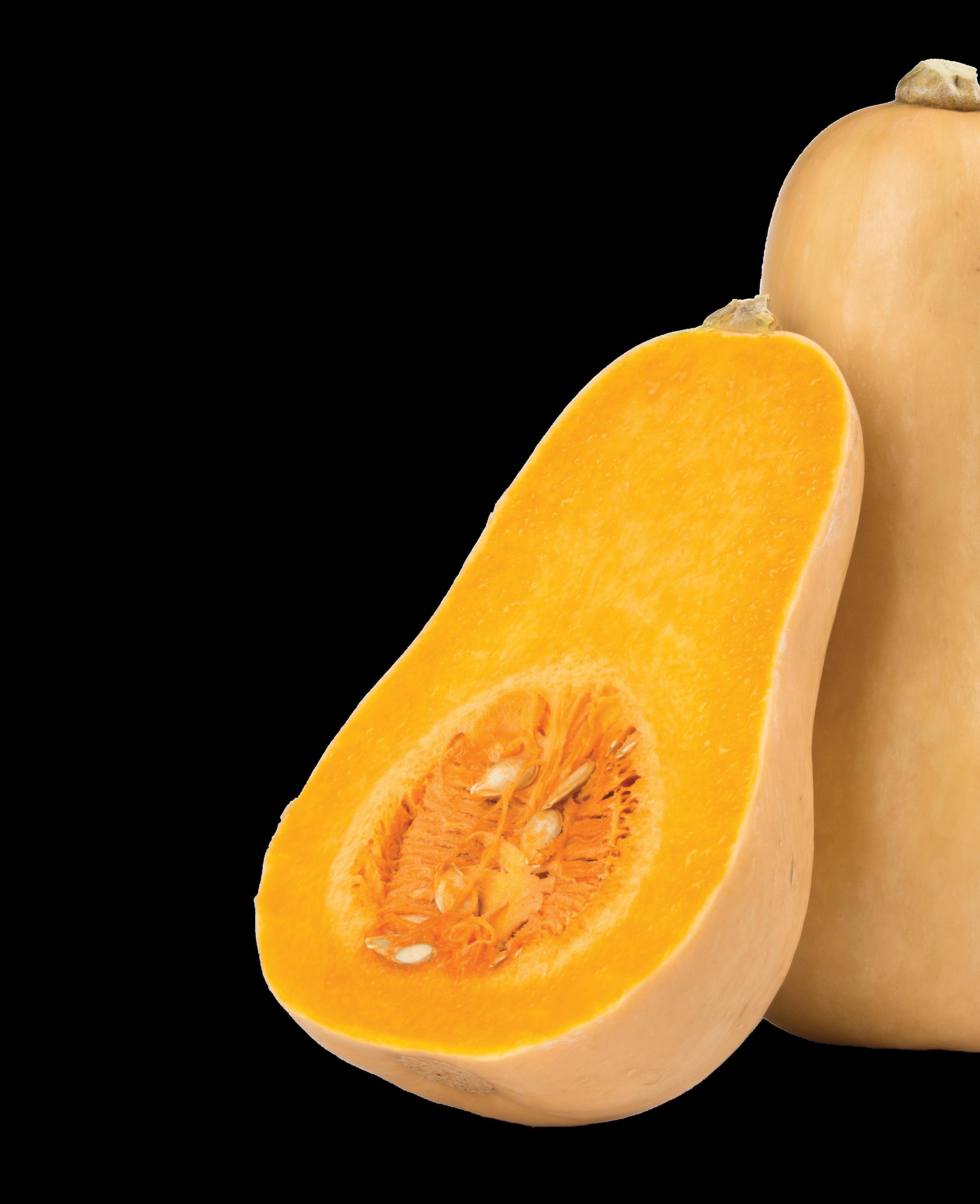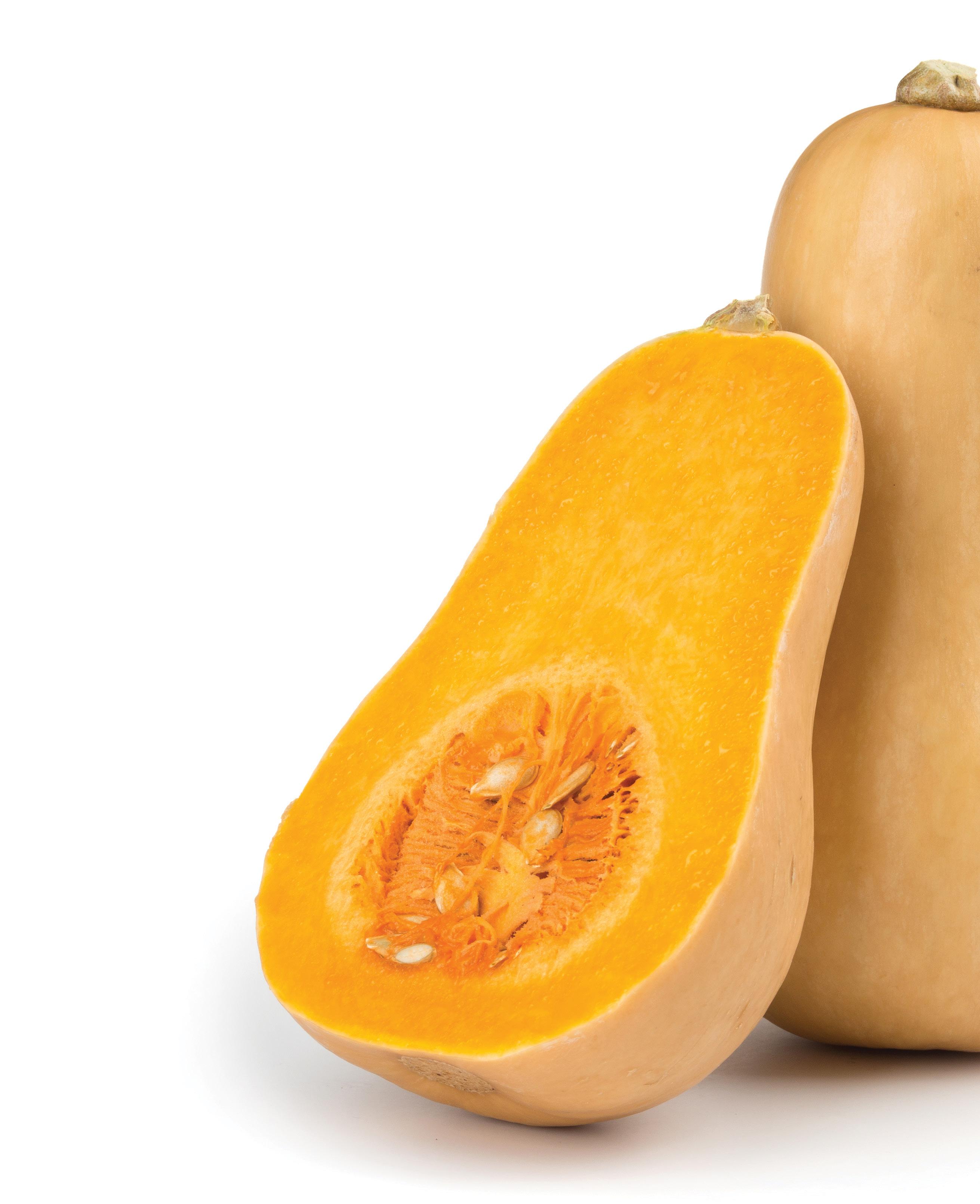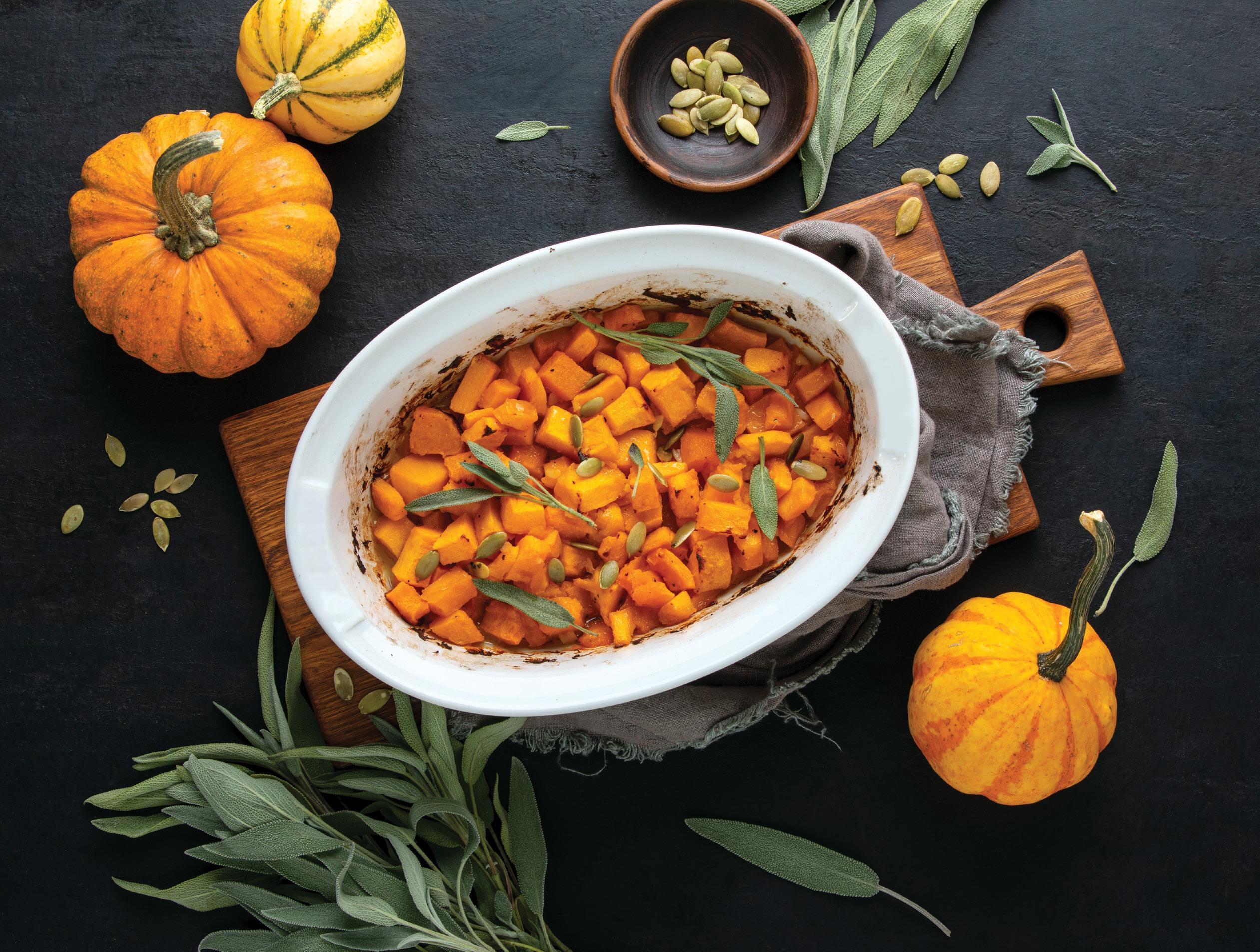
7 minute read
What’s Up, Butternut
It’s easy to prepare delicious butternut and other winter squashes.
Winter squash — a misleading title for these versatile vegetables since some are available year-round or in season starting in early fall — includes spaghetti, butternut, acorn, and turban squash, to name a few! Most winter squashes have a tough outer rind that becomes firmer as the squash matures, making them hearty vegetables that can last for months off the vine and hold up through the winter. Many people use winter squash both as fall decorations and in the kitchen.
Advertisement
When it comes to winter squash recipes, pumpkins are usually the star of the show. There are festivals and events revolving solely around this orange gourd. However, another orange squash has been gaining in popularity — butternut squash.
Butternut squash can be found yearround in grocery stores, but its peak season is from early fall to winter. When buying a whole squash, look for a heavier product with a fat neck and small bulb. A squash with a bigger bulb and small, thin neck is likely to have more seeds. Use the knock test to check for ripeness: a hollow sound when knocking means the squash is ripe, and a dull sound means the squash is either under or over-ripe.
Butternut squash is a great source of vitamin A, vitamin C and fiber. Vitamin A in the form of beta-carotene makes the flesh of the squash a dark, vibrant orange. One cup of cubed, baked butternut squash contains greater than 450% of your daily requirements for vitamin A.* It’s also a good source of potassium, magnesium, and vitamin B6.
Due to its rich flavor profile and natural sweetness, butternut squash can pair with both sweet and savory dishes. Many restaurants will puree the squash for soup. These soups are thick and delicious, but they tend to be loaded with brown sugar and butter. Other recipes use butternut squash in place of sweet potatoes. The squash can even be eaten raw on top of salads. With so many options, it’s easy to prepare butternut squash in the comfort of your kitchen.
Safety tip: Winter squashes have a thick rind that can be difficult — and sometimes dangerous — to peel and cut. Practice good knife skills, and take safety measures when preparing these vegetables. Using a fork or paring knife, poke holes in the squash’s rind, then microwave the squash for 2 to 4 minutes to soften it before cutting or peeling. You can then use a vegetable peeler to easily remove the skin, which is helpful if you plan to cube the squash. You can also use this softening method when cutting the squash into halves to be roasted with the skin.
By Kate Mirly, MS, RDN, LD, Boone Hospital Center Registered Dietitian

*Based on USDA FoodData Central
Roasted Butternut Squash

INGREDIENTS
• 1 whole butternut squash
• 2 Tbs olive oil
• Seasonings of choice to taste
Suggestions: Try a simple sprinkle of salt and black pepper, a savory combination of rosemary and garlic, or a sweet mix of cinnamon, nutmeg, and brown sugar. Add a dash of cayenne pepper with cinnamon for a warm flavor blend.
DIRECTIONS
• Preheat the oven to 400°F.
• With a fork or paring knife, pierce holes in the skin of the squash.
Microwave whole squash for 2 to 4 minutes.
• Use a vegetable peeler to remove the skin from around the squash.
Cut the squash in half width-wise between the bulb (thicker part) and the neck (thinner part). The bulb should contain all the seeds.
Cut the bulb in half and scoop out the seeds with a spoon.
• Cut seeded, peeled squash into 1-inch cubes.
• Toss the cubes in olive oil and seasonings of choice. Arrange the cubes in one even layer on a baking sheet.
• Roast for 25 to 30 minutes.
QUESTIONS & ANSWERS ABOUT IMMUNIZATIONS
To vaccinate or not to vaccinate? The safety and efficacy of immunizations have been debated for many generations. When it comes to raising children, there are a lot of decisions to be made, which can lead to anxiety for you as a parent. However, information is power. The more informed you are, the easier it is to confidently make decisions for your children.
BY MARIA BICKELL, BSN, RN, IBCLC, BOONE FAMILY BIRTHPLACE
The following is a list of commonly asked parental questions and concerns. It is important, however, that you feel comfortable enough to speak openly with your child’s health care provider so that you can determine the risks and benefits for your individual children.
1. Is it necessary to immunize my child against vaccine preventable diseases that have not been around
for many years? The reason these diseases have not been around for so long is because of widespread vaccination and herd immunity — an effect that occurs when enough people are vaccinated that people who can’t get the vaccine are also protected from a virus. Although it’s hard to imagine this benefit if you’ve never personally experienced or been witness to any potentially deadly diseases in your lifetime, vaccinations have proven to be the main cause of a person’s good health today in the U.S. The chance that these diseases would come back, however, could increase if a significantly smaller number of people are vaccinated. Vaccines not only protect your child, but many other people you care about.
2. Isn’t it better for my child to be exposed to the actual disease rather than develop immunity from
a vaccine? Although the chance of your child getting a vaccine-preventable disease is statistically low, there is an advantage in passive immunity, which occurs when you receive a vaccine, overactive immunity, which develops when you are infected with the actual virus. The major advantage of a vaccine is more immediate protection with a less severe physical response, fewer symptoms, and a lower risk of complications. As the Centers for Disease Control and Prevention (CDC) states on its website, “Your child might never need the protection vaccines offer. However, you don’t want them to lack the protection vaccines provide if they ever do need it.”
3. What about the side effects? The most common side effects of vaccinations, if they do occur, are typically minor, regardless of the specific type of vaccine. These side effects may include pain or swelling at the injection site and a low-grade fever for one to two days following administration. Severe, long-lasting side effects or anaphylaxis (severe allergic reaction) is extremely rare. In addition, vaccines are continually monitored
NEED MORE SUPPORT?
Bringing Up Boone Babies is a support group provided by Boone Family Birthplace that is free and open to all parents of newborns, infants, and toddlers.
To join our Bringing Up Boone Babies Facebook group, visit boone.org/ BringingUpBooneBabies

for safety just like any other medication. Read the “Vaccine Information Statement” provided by your child’s health care provider or visit the CDC website for more detailed information about specific vaccines.
4. What about the time and money?
Most insurance companies cover vaccines at 100%. There is a federal program in place for coverage of children who are underinsured or uninsured. Not only do childhood vaccinations have minimalto-no cost, in the long run, they can also help parents by limiting the amount of time taken off work or the added health care expenses for having a sick child. The development of combination vaccines has also helped lower costs. Giving several vaccinations at the same time with a single needle stick also means fewer office visits and less trauma for your child.
5. What about the other substances in
the vaccines? Vaccines today no longer contain the preservative thimerosal, which once caused concern regarding exposure of an infant to a higher than recommended level of mercury. According to past and present scientific research, there is no relationship between vaccines (particularly MMR) and autism or between thimerosal and autism. Yes, there are trace amounts of other additives found in vaccines, but the substances that remain are already found normally in the human body. For more information about these ingredients, visit the CDC website.
For more information about childhood immunizations, ask your child’s health care provider or visit cdc.gov/vaccines/










